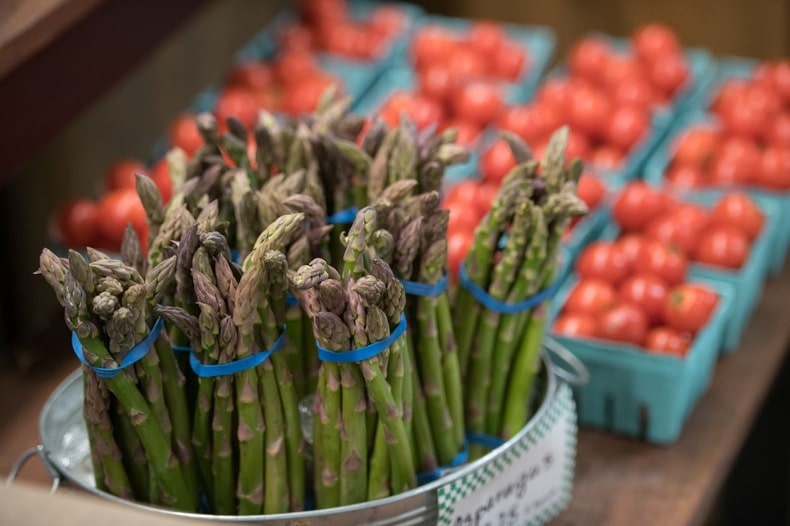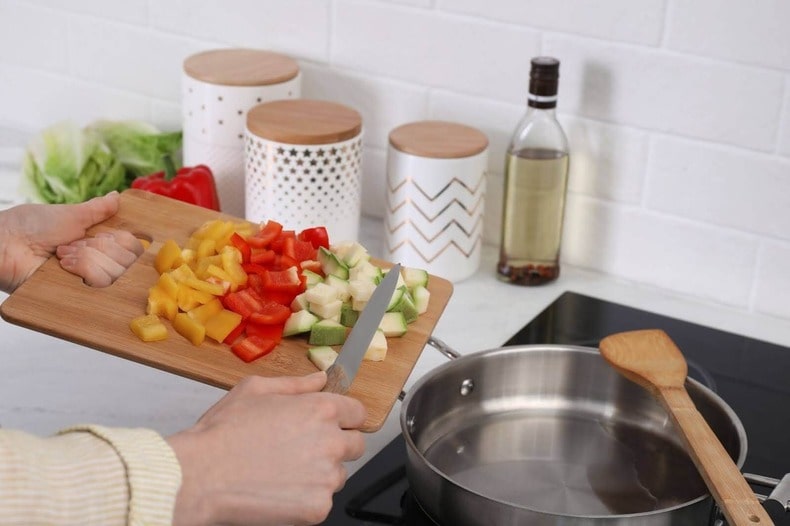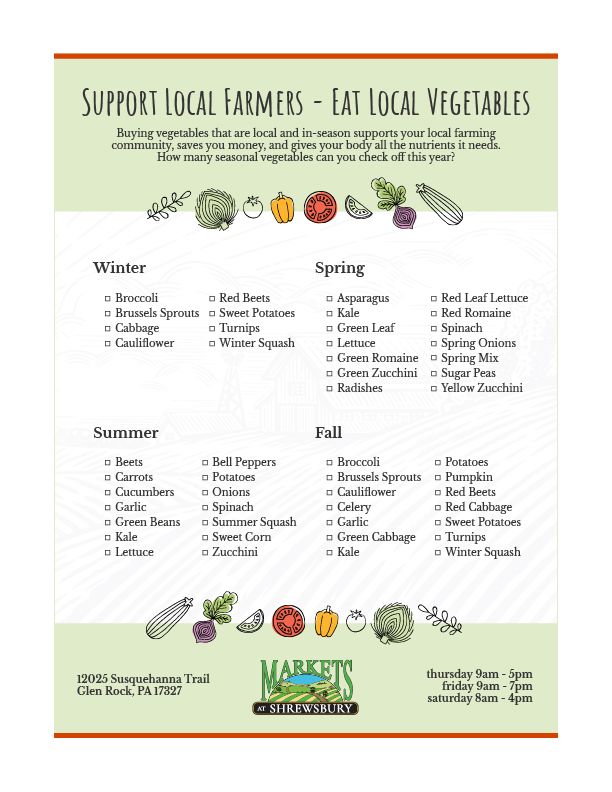Vegetables are a staple as snacks and on the dinner table year-round. They are affordable and versatile, and many of them are available during all four seasons.
But just because they’re available all year long doesn’t necessarily mean they’ll taste the best during every season.
To get the crunchiest, most nutrient-rich veggies from the harvest, it’s crucial to know what vegetables are in season in PA during the year.
Use our PA seasonal produce guide below to explore the best vegetables to enjoy during Summer, Spring, Fall, and Winter.
Why Eat PA’s Seasonal Produce?
In general, vegetables are less picky about their growing conditions and have better availability year-round compared to fruits.
That being said, there are still peak growing times for seasonal vegetables in Pennsylvania and the rest of the northeast.
Here are some reasons to buy PA’s vegetables by the season:
Higher Nutritional Value
The chemical makeup of a vegetable is directly linked to its ripeness. Vegetables grown in season are richer in micro-nutrients — a fancy way of saying they’re packed with more nutrients and better for your body.
Cost
Seasonal vegetables are less expensive for farmers to grow, which means they will probably be cheaper for you to buy! You can buy higher volumes and varieties of that season’s produce.
Taste
It’s a simple fact — vegetables grown in season simply taste better! There’s a reason that many restaurants focus their menus on in-season produce. These vegetables give maximum flavor for the best value.
How to Choose The Best Vegetables
Vegetables are much more forgiving than fruits when it comes to ripeness and have a longer freshness window. While each vegetable has individual signs that they’re ready to eat, you should generally look for:
- Even texture
- Consistent color
- Uniform firmness
- No give when squeezed

Buying Guide For What Vegetables Are in Season in PA
Start taking advantage of the benefits of Pennsylvania’s seasonal produce! Here are some of the vegetables you can expect to see at your local farmer’s market or grocery store during each season.
Spring Vegetables in Pennsylvania
Warmer weather brings bright leafy greens and other vegetables. Paired with seasonal Spring fruits like strawberries and tomatoes, they make for some healthy, delicious salads.
Here are some of the vegetables that can be found in season in Spring:
- Arugula
- Asparagus
- Kale
- Green Zucchini
- Leaf Lettuce (Red and Green)
- Mushrooms
- Parsnips
- Potatoes
- Radishes
- Romaine Lettuce (Red and Green)
- Spinach
- Spring Onions
- Spring Mix
- Sugar Peas
- Yellow Zucchini
Summer Vegetables in Pennsylvania
Summer brings a bounty of produce from all over Pennsylvania! Both fruits and vegetables flourish thanks to the rainy Spring weather and rising temperatures.
Check out the wide variety of PA’s Summer vegetable harvest:
- Arugula
- Beets
- Bell Peppers
- Broccoli
- Cabbage
- Carrots
- Cauliflower
- Celery
- Cucumbers (Excellent for Pickling!)
- Garlic
- Green Beans
- Kale
- Lettuce
- Mushrooms
- Onions
- Shallots
- Summer Squash
- Sweet Corn
- Zucchini
Fall Vegetables in Pennsylvania
While fruit yields dwindle in the Fall, there are tons of vegetables ready for picking. Here are plenty to add to your shopping list:
- Beets
- Bell Peppers
- Broccoli
- Brussels Sprouts
- Cabbage
- Carrots
- Cauliflower
- Celery
- Garlic
- Green Beans
- Kale
- Mushrooms
- Onions
- Parsnips
- Potatoes
- Pumpkins
- Red Beets
- Spinach
- Sweet Potatoes
- Turnips
- Winter Squash
Winter Vegetables in Pennsylvania
There are significantly fewer in-season fruits during the Winter, but this is the time of year when root vegetables shine. PA’s Winter vegetables are perfect for comfort food favorites, from broccoli cheese soup to sweet potato casserole.
Here are a few of PA’s seasonal vegetables you’ll find in winter:
- Beets
- Broccoli
- Brussels Sprouts
- Carrots
- Celery
- Mushrooms
- Parsnips
- Potatoes
- Pumpkins
- Red Beets
- Shallots
- Sweet Potatoes
- Turnips
- Winter Squash (Acorn, Butternut, Spaghetti)
PA’s Monthly Seasonal Produce Guide Chart
| Jan | Feb | March | April | May | June | July | Aug | Sept | Oct | Nov | Dec | |
| Arugula | ★ | ★ | ★ | ★ | ★ | |||||||
| Asparagus | ★ | ★ | ★ | ★ | ||||||||
| Beets | ★ | ★ | ★ | ★ | ★ | ★ | ★ | |||||
| Bell Peppers | ★ | ★ | ★ | ★ | ||||||||
| Broccoli | ★ | ★ | ★ | ★ | ★ | ★ | ||||||
| Brussel Sprouts | ★ | ★ | ★ | ★ | ||||||||
| Cabbage | ★ | ★ | ★ | ★ | ★ | ★ | ★ | ★ | ||||
| Carrots | ★ | ★ | ★ | ★ | ||||||||
| Cauliflower | ★ | ★ | ★ | ★ | ★ | |||||||
| Celery | ★ | ★ | ★ | ★ | ★ | ★ | ★ | ★ | ||||
| Cucumber | ★ | ★ | ★ | |||||||||
| Garlic | ★ | ★ | ★ | ★ | ||||||||
| Green Beans | ★ | ★ | ★ | ★ | ||||||||
| Kale | ★ | ★ | ★ | ★ | ★ | ★ | ★ | ★ | ||||
| Lettuce | ★ | ★ | ★ | ★ | ★ | ★ | ||||||
| Mushrooms | ★ | ★ | ★ | ★ | ★ | ★ | ★ | ★ | ★ | ★ | ★ | ★ |
| Onions | ★ | ★ | ★ | ★ | ★ | |||||||
| Parsnips | ★ | ★ | ★ | ★ | ★ | |||||||
| Potatoes | ★ | ★ | ★ | ★ | ★ | ★ | ★ | ★ | ★ | |||
| Pumpkins | ★ | ★ | ★ | ★ | ||||||||
| Radishes | ★ | ★ | ★ | ★ | ||||||||
| Shallots | ★ | ★ | ★ | ★ | ||||||||
| Spinach | ★ | ★ | ★ | ★ | ||||||||
| Sugar Peas | ★ | ★ | ★ | |||||||||
| Summer Squash | ★ | ★ | ★ | ★ | ★ | |||||||
| Sweet Corn | ★ | ★ | ★ | ★ | ||||||||
| Sweet Potatoes | ★ | ★ | ★ | ★ | ||||||||
| Turnips | ★ | ★ | ★ | ★ | ★ | ★ | ★ | |||||
| Winter Squash | ★ | ★ | ★ | ★ | ||||||||
| Zucchini | ★ | ★ | ★ |
*Reference: https://www.seasonalfoodguide.org/

Elevate Your Cooking with Vegetables
While you may think steamed broccoli and cooked spinach are boring, there are tons of innovative ways to prepare your vegetables to complement your cooking.
From sauteeing to air frying, check out some of our favorite methods for cooking with vegetables.
It probably goes without saying, but always make sure to rinse or wash your vegetables before consuming — using any cooking method, but especially raw — to remove any stubborn dirt or fertilizer.
Raw
Raw veggies have tons of micronutrients and a unique crunch that can satisfy cravings for other carb-heavy snacks. If carrots and ranch aren’t your thing, try using some fresh cucumbers and garlic to make this homemade Greek tzatziki dip.
It pairs great with other crunchy veggies like broccoli, sweet peppers, and carrots, or with some warm pita bread.
You can also try quick pickling some of your raw veggies to add some extra flavor to your favorite snacks or meals!
If you’re struggling with eating enough raw veggies but want to reap the benefits of adding them to your diet, try tossing some greens into your favorite fruit smoothie for some extra nutrients.
Boiled & Steamed
Boiling or steaming vegetables makes them tender and brings out their natural colors. Boiling requires the vegetables to be cooked directly in the water, while steaming uses the moisture that the boiling water puts off.
Both options soften the produce and are great for broccoli, cauliflower, green beans, spinach, asparagus, and small fingerling potatoes.
Sauteed & Stir-Fried
Sauteing and stir-frying is the practice of cooking vegetables in a small amount of oil or butter on the stovetop. The main difference between the two is that stir-frying uses a higher heat and cooks the vegetables much faster than sauteing.
Both methods are fast and help lock in the vegetables’ flavor, color, and nutrients. Try one of these methods next time for vegetables like peppers, onions, zucchini, green beans, asparagus, mushrooms, or spinach.
Roasted & Baked
Roasting and baking are low-effort methods of cooking vegetables because they require very little supervision. Simply chop your veggies, drizzle with olive oil, and lightly season with salt and pepper (and whatever else your family loves) before placing them into the oven.
A quick flip halfway through is all you’ll need for perfectly browned, caramelized broccoli, cauliflower, brussel sprouts, potatoes, onions, garlic, zucchini, carrots, and squash.
Air and Oil-Fried
Frying vegetables sounds like a bit of an oxymoron, but with air and oil-frying options, you can find the perfect balance of flavor and nutrition. If you’re looking for a healthier frying snack, air frying will preserve some of the vegetables’ nutrients. If you’re looking for an indulgent treat, enjoying a traditional oil-fry vegetable in moderation won’t hurt.
Try oil or air-fried zucchini fritters, corn fritters, onion, shallots, sweet potatoes, or fresh-cut fries.
Grilled
Grilled vegetables are a Summertime favorite in many PA households. The heat caramelizes the veggies for a unique smoky flavor that is hard to imitate with any other method.
Next time you’re prepping for that Summer BBQ with your family and friends, try grilling up some peppers, onions, zucchini, summer squash, corn, or asparagus alongside your meat.
How Many of PA’s Seasonal Vegetables Can You Try?
We challenge you to keep track of how many in-season vegetables you try this year! Print out our PA seasonal vegetables sheet to keep track of how many in-season veggies you and your family enjoy this year.

This blog was originally published in April 2019. It was updated in May 2024.




